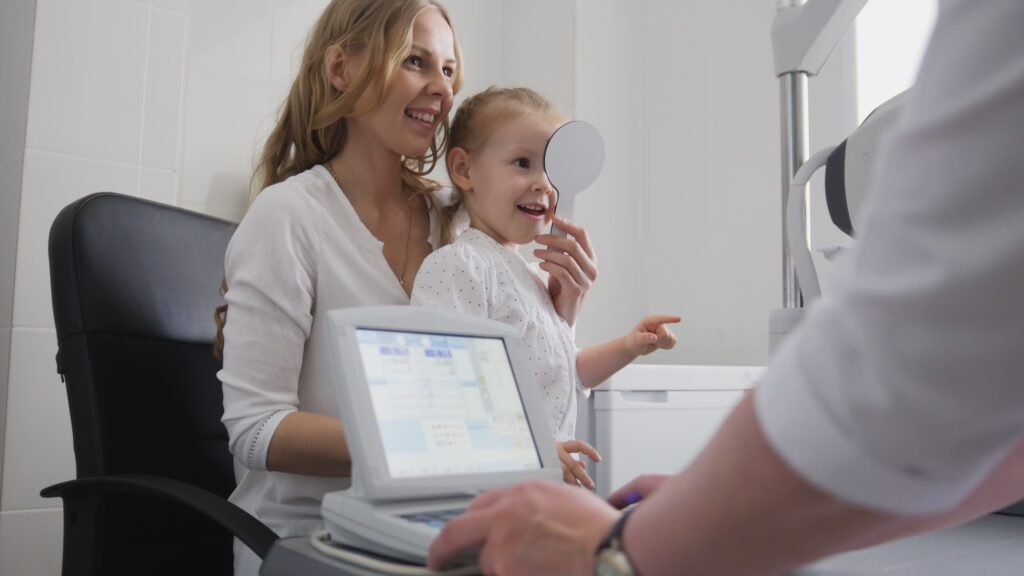When kids start preschool, we make sure their shots are up to date and their backpack fits. But what about their eyes? Many vision problems show no obvious signs yet they can affect how a child learns, plays, and even builds confidence. That’s why current guidance recommends systematic screening.
Vision disorders such as Amblyopia (lazy-eye), Strabismus (eye-turn), and significant uncorrected refractive error (nearsightedness, farsightedness, astigmatism) are among the most common in preschool-aged children. Early detection means earlier intervention, which generally leads to better outcomes, especially since younger children respond more to treatment.
When you catch a vision issue early:
- A child doesn’t have to struggle unnecessarily with reading, learning, coordination or confidence.
- The more time you permit amblyopia or strabismus to go un-treated, the harder it is to treat effectively.
- Good vision is part of overall development — social, academic, physical. One review connected moderate-to-high farsightedness in preschoolers with reduced school-readiness.
So the updated guidance from the National Center for Children’s Vision and Eye Health (NCCVEH) recommends annual (rather than once) vision screenings for children ages 3 to 6. These updated recommendations expand on earlier 2015 standards to include testing both near and distance vision, plus 3-D (stereopsis) vision. A key step for catching problems early.
What’s in a Vision Screening?
Here’s a parent-friendly checklist of what an annual preschool vision screening should include.
- Observation (“Does the child look okay when playing / reading / watching?”)
- Does your child squint, tilt their head, cover one eye, close one eye when looking?
- Do they seem to avoid using one eye, misalignment, an eye turning or prefer one side?
- Distance vision test (how well each eye sees at “far away”)
- Using symbols appropriate for young children (not adult letters).
- Each eye tested alone (the other eye covered).
- For a 3-year-old: we expect they can “read” or match to the 20/50 line.
- For a 4 or 5-year‐old: expectation is 20/40 and 20/32 or better
- Near vision test (how well each eye/eyes see up close)
- Since children do a lot of near work (books, tablets, play), this is important.
- Stereopsis (3-D vision / how well the two eyes work together to give depth perception)
- A simple way to think of this: are the eyes “team players” or does one dominate?
- Poor stereopsis may signal strabismus or amblyopia risk.
- Referral plan / follow-up
- If the child fails any of the above OR if there are obvious warning signs like eye misalignment, family history, developmental concerns, then a comprehensive eye examination by a pediatric-friendly optometrist or ophthalmologist is the next step.
- Even if the screening is “passed”, but parents or teachers are concerned or there is a family history of vision problems, consider a full eye exam.
Why This Matters
Early treatment for conditions like lazy eye or eye turns can prevent permanent vision loss. Clear, comfortable vision also supports school readiness, reading, and confidence. Kids don’t always know when something looks blurry. They assume everyone sees the same way!
Tips for Parents & Teachers
- Make it routine: schedule a screening every year, just like dental visits.
- Watch for warning signs: rubbing eyes, sitting too close, clumsiness, avoiding reading.
- Ask what was tested: both near and distance? each eye separately?
- Follow up fast if a referral is given. Early care makes all the difference.
We’re Here to Help
At Monarch Bay Optometry in Dana Point, we make eye screenings easy and child-friendly.
Our doctors are good observers and will check near, far, and 3-D vision. They can also provide a full pediatric eye exam right here in our office if needed.
👁 Call today to schedule your child’s annual vision screening. Early detection builds a lifetime of healthy sight!
Book AppointmentReferences
- Pang Y, Cotter SA, et al. Optometry and Vision Science. 2025; 102(5): 357–366.
- Cotter SA, Cyert LA, et al. Optometry and Vision Science. 2015; 92(1): 6–16.
- National Center for Children’s Vision and Eye Health, Prevent Blindness. Vision Screening Guidelines by Age.
- Tarczy-Hornoch K et al. “Vision Screening for Children 36 to <72 Months: Recommended Practices.” 2015.


